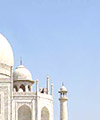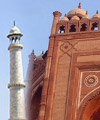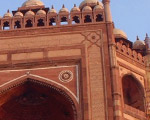|
Varanasi
Varanasi, India's most sacred city is situated on the West bank
of the Ganga. Varanasi is also known as Benaras. Varanasi derives
its name from two streams, the Varuna on the North side of the city
and the Assi, a small trickled on the south. Varanasi is said to
combine all the virtues of all other places of pilgrimage and anyone
dying within the area marked by the Panch Kosi road is transported
straight to heaven. It is also an important pilgrimage centre for
Buddhists as it was at Sarnath (10 km from Varanasi), Lord Buddha
gave his Ist sermon after enlightment. Varanasi today, is also a
centre of education, art and craft.
Exscursion
Chunar
Chunargarh of 'Chandrakanta', the classic novel by Babu Devakinandan
Khatri is 40 kms from the city of Varanasi. Today the place is known
as Chunar. Along one of the meanders of Ganges, where the Kaimur
Hills are taking a North face, are built the imposing fort of Chunar.
Sarnath
About ten kms from Varanasi, is the place where lord Buddha after
enlightenment gave his first sermon or as the Buddhist say set the
wheel of dharma or law rolling. Today Sarnath is considered as one
of the richest place to have antiques since the Ashoka period to
the 12th century. Suggested reading on the Buddhist places in Uttar
Pradesh.
Jaunpur
In 1360 Feroz Shah built this town to guard the eastern side of
his Delhi sultanate. Jaunpur is located 65 kms from Varanasi. Jaunpur
is bisected by the river Gomti and the two sides are connected by
the massive Akbari Bridge. This bridge was designed by an Afghan
and was built in the 16th century. The fifteen stone arches of the
bridge have withstood earthquakes and floods. On the southern end
of the bridge is the sculptures of a lion tussling with an elephant.
This marked the provincial milestone. Other places to visit in Jaunpur
are Sheetla Chowkia Dham, Yamdagni Ashram, Atla Mosque and Char
Anguli ki Masjid.
Vindhyachal
There are many Shaktipeeths in India. These are the places where
the Goddess of power is said to be residing and people worship her
viz- Goddess Durga. Vindhyachal is one of such peeths or abode of
Shakti. The place is 90 kms from Varanasi. The temples of Vindhyavasini
Devi, Asthbhuja and Kalikhoh are a must visit here.
Kaushambi
The mention of this town can be seen in the Mahabharata. It is said
that the Pandav brothers lived here. Budhha visited this place many
times and the gave sermons after his enlightenment in 6th and 9th
century. Kaushambi developed as a major center for Buddhism. The
ruins of an old fort tells the saga of the towns antiquity. Kaushambi
is 185 kms from Varanasi.
Chandra Prabha Wildlife Sanctuary
Established in 1997, Chandra Prabha Sanctuary, a small sanctuary
sprawling over an area of 78 sq. kms, is located on Naugarh and
Vijaigarh hillocks in Vindhya forest range, in Chandauli district.
Kaimoor Wildlife Sanctuary
Kaimoor sanctuary, located on the Uttar Pradesh - Bihar border,
is spread over an area of 500 sq. kms.
The
Ghats Of Varanasi
In this ancient city of pilgrimage, the bathing ghats are main attraction.
People flock here in large numbers every day to take bath and worship
in the temples built beside the river bank. Centuries old tradition
to offer puja to the rising Sun is still maintained.
St. Mary's Church
Situated in the cantonment area of Benaras (Varanasi) the St. Mary's
Church has a low tower, spire and projecting poitico. Instead of
windows tile, church has louvred doors to the sides and hooded ventilation
slots beneath the cornice.
The Kashi Vishwanath Temple / Gyanvapi
Mosque
This temple is dedicated to Lord Shiva. It is popularly known as
the golden Temple due the Gold plating done on its 15.5 meter high
spire. One tonne of gold donated by Maharaja Ranjit Singh has been
used in the gold plating of the spire. The temple was destroyed
in the various invasions and was rebuilt in 1776 by Rani Ahilyabai
of Indore.
Bharat Mata Temple
This temple is dedicated to Mother India. Just one kilometer from
the Varanasi station. The temple is built in the Mahatma Gandhi
Kashi Vidyapeeth which was built by Babu Shiv Prasad Gupt. This
temple was inaugurated by Mahatma Gandhi in 1936 so that the citizens
could respect Mother India in statue form. The statute is built
in marble. The statue is a replica of undivided India in three dimension
which has the mountains, plains and oceans in right proportion.
Tulsi Manas Temple
This temple is dedicated to Lord Rama. The temple is built in the
place where Goswami Tulsidas composed the epic 'Ramacharitramanas'
which provides us with detailed description of the history and deeds
of Lord Rama. Tulsi Manas Temple was constructed by a philanthropist
family in 1964.
Durga Temple
Built in the 8th century, the Durga temple is one of the most important
temples in Varanasi. This temple is built in Nagara Style. The shikhara
of the temple is formed by many small spires which are built one
on top of the other.
Nepali Temple
The King of Nepal had built this temple on Lalita ghat in Nepali
style. The Nepali temple is also called the 'Kathwala temple'. The
temple has some magnificent woodwork. Tourist from all over the
world come just to see this temple which has no comparison with
any other temple in India. The workers who carved this temple out
were brought from Nepal. The wood used in the temple is also found
in Nepal. The speciality of this wood is that termites do not eat
this wood.
Top
Bharat
Kala Museum
The Kashi Hindu university has a museum which has a very rich collection
of precious and rare historical artifacts, statues, pictures, paintings
and manuscripts. This small but very well maintained museum gives
an over view of the ancient city of Varanasi. Entry in the museum
is free but check out the timings.
Ram Nagar Durg
2 kms from the Kashi Hindu university, across the Ganges is located
the ancestral house in the fort which was built by the former rulers
of Kashi. In one of the sections of the fort is the museum which
displays the royalty which was once part of the kingdom.
This museum gives an insight into the grandeur which once prevailed
in the fort. On the Ramnagar Pandav road is a beautiful Durga temple.
This temple has very delicate and intricate carving done on stone.
These carvings are worth giving a look.
- Other Attractions of Varanasi
Benaras Hindu University
This is the largest and oldest university in north India. Spread over
an area of 2,000 acres, this great place of education was established
by Pt. Madan Mohan Malaviya. Today the campus has faculties of Arts,
Science, Music, Sanskrit, Languages, Engineering, Statistics and Medical
to name a few of them.
The university also has the huge Vishwanath temple which was built
and maintained by the Birla family. The Sunderlal Medical center
has all the modern facilities of medical field is also located in
the university campus.
Nandeshwar Kothi
Nandeshwari
Kothi, designed by James Prinsep is a typical building of the early
19th century in Benaras.
Jantar Mantar
The ruler of Jaisingh built an observatory in Varanasi in line with
those built in Delhi, Mathura, Ujjain and Jaipur observatories.
The Varanasi observatory has all the instruments which were required
to record the motion , speed and properties of various stars and
planets and other cosmic objects. The observatory was built in 1600
and still the instruments give the exact measurements which can
match any modern instrument.
Top
Fairs & Festival
Kartik Purnima
Celebrated in the month of November-December is the sacred day,
when the ghats of Varanasi come alive with thousands of brightly-lit
earthern lamps.
Buddh
Purnima
This festival is celebrated with pomp and gaiety in Sarnath. This
day Lord Buddha was born. A large fair is held in Sarnath and the
relics of Buddha are taken out in a procession for public viewing
on this day. Buddh Purnima is celebrated during the month of May.
Ganga Festival
A festive experience like none other awaits you at Ganga Festival
at Varanasi.
The Ramlila
The Ramlila of Ramagar is famous far and wide. The Ramlila is based
on the Ramcharitramanas by Tulsidas. The month ling festival is
usually held during October / November and it sees the performance
of many ancient rituals.
Bharat Milap
Around Dussehra a fair is held in Nati Imli which celebrates the
return of Lord Rama from 14 years of exile. His reunion with his
younger brother Bharat is celebrated as Bharat milap. This festival
is attended by the king of Kashi in royal flavour. The festival
is attended by at least a million devotees. Held in the month of
October / November.
Hanumat Jayanti
This festival is celebrated to mark the birth of the monkey God
Hanuman . The five day long festivities are held at the Sankat Mochan
temple. During this festival many plays are staged based on the
Saraswati, Ram , Krishnalila and Hanuman Charitra.
Nakkatyya
This festival again is based on the Ramayana. The episode in the
epic where the sister of Ravana tries to influence Lakshmana to
marry her but instead Lakshman chops off her nose. On hearing this
Ravana vows revenge against the brothers. This incidence in the
epic is one of the reasons why Sita was abducted by Ravana. The
festival is held in Chetganj with much fan fair.
Mahashivratri
Though Mahashivratri is celebrated throughout India, Varanasi has
some special charm in the celebration the festival. During the festival
a procession is taken out from the Maha-Mritunjaya temple to Kashi
Viswanath Temple.
Panch Koshi Parikrama
The procession has got the name because it passes through five places.
These five places are Kardmeshwar, Bhimchandi, Rameshwar, Shivpur
and Kapildhara. The parikrama has special importance in the ancient
parikramas of India. The procession starts and ends at Manikarnika
Ghat.
The Dhrupad Mela
In the month of March a five day long music festival is organised
on the Tulsi Ghats. during the five days renowned artists from all
over the country perform Dhrupad here. This festival is one of the
major tourist attraction of Varanasi.
Top
Getting There
By Air
Indian Airlines connect Varanasi to Bhubaneshwar, Lucknow, Agra &
Delhi, where the above places are directly connected by flights with
Calcutta.
By Rail
Varanasi is connected by rail with all the major cities in India.
By Road
Good bus service connects Varanasi with most of the important places
of Uttar Pradesh and Bihar. Some of the road distances are:- Agra
610 kms, Allahabad 127 kms, Bodh Gaya 240 kms, Gorakhpur 215 kms,
Khajuraho 406 kms, Kushinagar 260 kms, Lucknow 320 kms, Lumbini
320 kms, Patna 270 kms Calcutta 681 kms, Bombay 1550 kms, Delhi
710 kms etc. Top
Weather
Temperature
Summer - Max : 460 C, Minimum 320 C
Winter - Max : 150 C, Minimum 050 C
Best Season - September -March
Top
General Information & Accomdation info on Varanasi city of Uttar Pradesh - India
|






